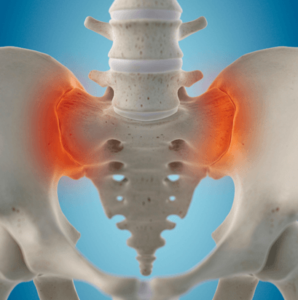The sacroiliac joint is an important part of your body that many people seem to forget about until it hurts. At our Carrollton Physical Therapy Clinic, we frequently treat patients experiencing SI Joint Pain. That is why it is so important to know what it is, how it affects you, and what treatment options might help alleviate your discomfort.
What is the SI Joint?
 The sacroiliac joint links the sacrum—the triangular bone at the bottom of your spine—to the pelvis’ iliac bones. This joint is designed to shift loads from your upper body down through your legs, providing stability and shock absorption while moving. It has only a rather narrow range of motion but makes all the difference in the maintenance of proper posture and balance.
The sacroiliac joint links the sacrum—the triangular bone at the bottom of your spine—to the pelvis’ iliac bones. This joint is designed to shift loads from your upper body down through your legs, providing stability and shock absorption while moving. It has only a rather narrow range of motion but makes all the difference in the maintenance of proper posture and balance.
How Is SI Joint Pain Affecting You?
SI joint pain can be sharp, stabbing pain in the lower back, buttock, or even down the legs. It can be misdiagnosed as various other conditions, such as sciatica or problems with the lumbar discs. Pain normally worsens with long periods of sitting, standing after being seated, or lifting heavy things. This discomfort inhibits the performance of normal activities regarding daily life and makes a person incapable of doing simple things.
Common Causes of SI Joint Pain:
- Trauma: A fall, car accident, or any kind of direct blow to the pelvis may cause an injury in the SI joint.
- Pregnancy: The hormonal changes during pregnancy can result in loosening of the ligaments surrounding the SI joint and increase the risk of pain.
- Arthritis: Certain conditions such as osteoarthritis or ankylosing spondylitis may cause inflammation in the SI joint.
- Leg Length Discrepancy: A discrepancy in the length of the legs can cause the pelvis to align unevenly, leading to pain in the SI joint.
- Repetitive Stress: Repetitive activities, such as running or heavy lifting, may stress the SI joint.
Tips to Manage SI Joint Pain:
Managing SI joint pain includes a little of both self-care and professional intervention.
Here are some tips:
- Rest and Ice: Rest combined with the application of ice to the affected area will help bring down the swelling and thereby reduce pain.
- Exercise: Gentle stretching and muscle strengthening exercises to the core and pelvis will increase stability and reduce discomfort.
- Posture: Maintaining good posture when sitting, standing, and lifting will help prevent further strain on the SI joint.
- Avoid Triggers: Identifying the triggers that exacerbate your pain—generally, continuous sitting or standing—will help manage symptoms.
How Our Physical Therapy Clinic in Carrollton Can Help: Dry Needling, Shockwave Therapy, and Manual Therapy
The PT clinic in Carrollton has specialized treatments aimed at alleviating SI joint pain, including:
- Dry Needling: This is a process whereby thin needles are stuck into the muscles, surrounding the SI area. This relieves tension, reduces inflammation, and increases the mobility in the area.
- Shockwave Therapy: This is a noninvasive treatment involving the generation of shockwaves that induce a healing process in the SI joint and are effective against pain. It helps mostly in chronic painful conditions of the lower back. Manual therapy incorporates hands-on techniques for mobilization and manipulation of the SI joint, which assists in realigning the joint, improving range of motion, and reducing pain. Conclusion
SI joint pain can be devastating, but with the right approach, it can be very well managed. If you are suffering from symptoms of SI joint pain, don’t hesitate to reach out for a consultation. Our team is here to get you moving again and enjoying a better quality of life.

Why SureCure Physical Therapy in Carrollton offers free consultation?
We want to empower people with knowledge so they can take better decision. Our goal with consultation is to provide information about root cause of problem, how individual can manage at home ? What is the prognosis for the diagnosis, ? And how can we help to manage pain? Many times you don’t need any therapy but just few changes and exercise can manage pain but sometimes you need skill care so we help people to make right knowledgeable decisions.
Click Here to Book your free consultation and start your journey to relief!
